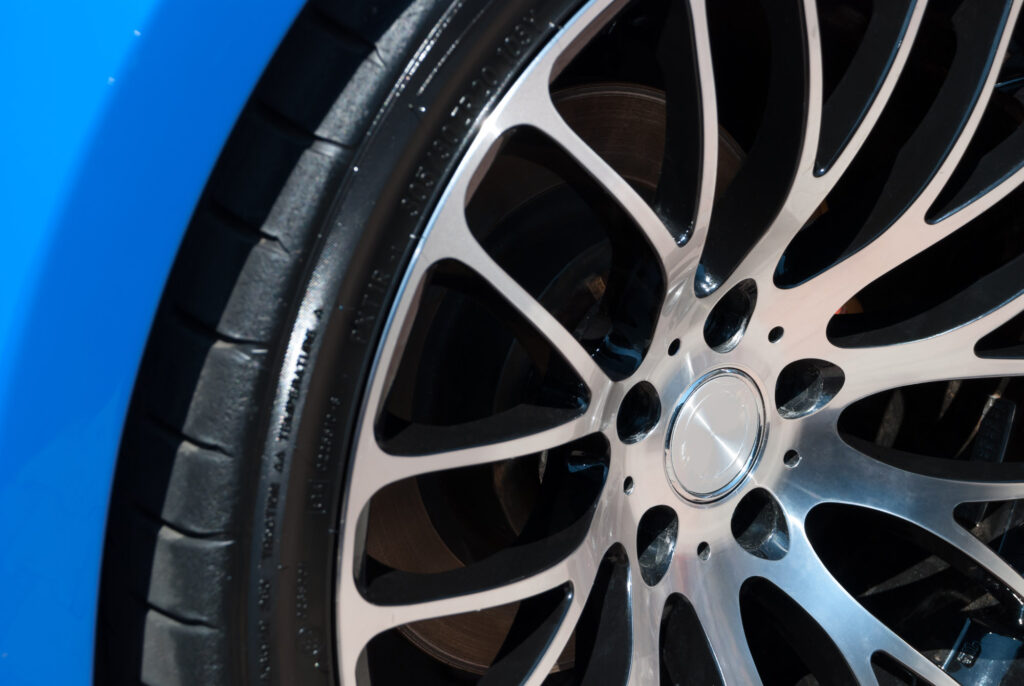Wheel rims are essentially the base to mount the tire. They support and distribute the vehicle’s weight evenly across the axles to maintain proper balance and stability when driving.
They’re also customizable, with some owners upgrading stock rims for bigger ones. Besides aesthetic appeal, there are lots of practical reasons to make the upgrade.
Pros of Bigger Rims on a Car
Many drivers invest in bigger rims for various reasons, like better stability, higher top speed, increased loading capacity, improved traction, improved cornering, better braking, higher ground clearance, and aesthetic appeal.
Better Stability
Bigger rims contribute to better stability because of the larger contact patches, which make vehicles more stable and balanced.
Larger rims also increase the ground clearance of off-road vehicles. This makes it easier and safer to navigate uneven and off-road terrain, reducing the risk of getting stuck in mud and potholes.
Higher Top Speed
While larger rims decrease your vehicle’s acceleration because of the added weight, they also increase the top speed. This is due to the engine needing to work less because the increase in rim size equates to lower revolutions per minute (RPM) to maintain certain speeds.

Increased Loading Capacity
Increasing the size of your rims also improves your vehicle’s weight capacity because it raises the amount of pressure your tires can hold. As a result, you can squeeze in more or heavier cargo than usual.
The increased loading capacity is useful if you plan to go on road trips with family and friends because you won’t have to worry about limiting the equipment and items you can bring.
Improved Traction
Traction refers to your tire’s grip on the road. Proper traction reduces the risk of slipping and skidding, even on wet surfaces. Tires have rubber treads that improve traction, producing the friction needed to stop moving when you hit the brakes.
Bigger rims mean larger tires and more treads for traction. While this increase might seem slight, it’s often enough to make better contact on the pavement.
Improved Cornering
Bigger rims allow for larger wheels, resulting in more road contact, wider tread, and stiffer sidewalls. All these add up to better cornering or the ability to navigate turns.
Better Braking
The aforementioned added rubber also improves your vehicle’s braking because it results in better grip and traction on the road. Bigger rims help decrease braking distance, which means you can come to a full stop faster when you brake.
Higher Ground Clearance
The bigger rims result in higher ground clearance, which is the distance between the lower end of the vehicle body and the road. They provide more leeway to avoid hazards or hurdles on the road, especially when driving off-road and other rough conditions.
Aesthetic Appeal
Car rims come in different designs, and the bigger variants show this aspect to full effect. They offer a great way to style up your vehicle without drastically changing its overall look.
Cons of Bigger Rims on a Car

Some disadvantages of bigger rims on cars include increased fuel consumption, decreased acceleration, accelerated tire wear, reduced rolling resistance, speedometer errors, safety system warnings, reduced ride comfort, and premature wear and tear.
Increased Fuel Consumption
Bigger wheels are heavier and generate more friction compared to smaller rims, making the engine work harder to move them. This, in turn, means the vehicle consumes more fuel than usual because the engine needs to overcome the resistance.
Decreased Acceleration
The added weight also makes it harder for the vehicle to accelerate. It also leads to a slightly heavier steering wheel, making it difficult to turn your vehicle from time to time. But as mentioned, larger rims lead to higher top speed. It just takes a while to reach.
Accelerated Tire Wear
The wheel scraping, heavy steering, and lower sidewalls of bigger rims make them more susceptible to tire wear. And since this type of damage can’t be repaired, you’ll have to replace the wheel entirely once it wears out.
Reduced Rolling Resistance
Rolling resistance refers to the resistance the tires deal with as they roll on the road or ground. The lower it is, the more dangerous it becomes to take sharp turns because of the lack of grip or friction when turning. Doing so could even result in overturning.
Speedometer Errors
Speedometers calculate the speed of the standard wheels that come with them. As such, modifications like installing bigger rims might throw off the speedometer’s calculations. Usually, this means slower reads than usual.
The inaccurate readings can make driving dangerous because they make it hard to tell what speed you’re driving at. They could also get you in trouble with the law if you accidentally break speed limits.
Safety System Warning
In the same vein as speedometer misreadings, bigger rims also mean some safety warning systems, such as the anti-lock braking system (ABS) and electronic brakeforce distribution (EBD), may not respond. This is because they’re calibrated to lighter wheels.
Reduced Ride Comfort
Larger rims could increase vibrations and noise inside the car, making for a less comfortable ride all around.
Premature Wear and Tear
Larger wheels also mean the increased odds of premature wear and tear on the steering system. Front end steering components tend to wear out faster when the wheels are bigger.
What Happens After I Get Rims for My Vehicle?
If you’ve ordered some big rims from our catalog and find yourself unhappy with them, don’t worry. With a CarParts Plus membership, you’re free to return any of your orders within two months.
CarParts+ offers excellent benefits, including extended 60-day returns.
You’ll also get access to other exclusive perks such as VIP Customer Service, Free Shipping, and 24/7 roadside assistance. Sign up for CarParts Plus today to have that extra confidence on the road.
Any information provided on this Website is for informational purposes only and is not intended to replace consultation with a professional mechanic. The accuracy and timeliness of the information may change from the time of publication.
































